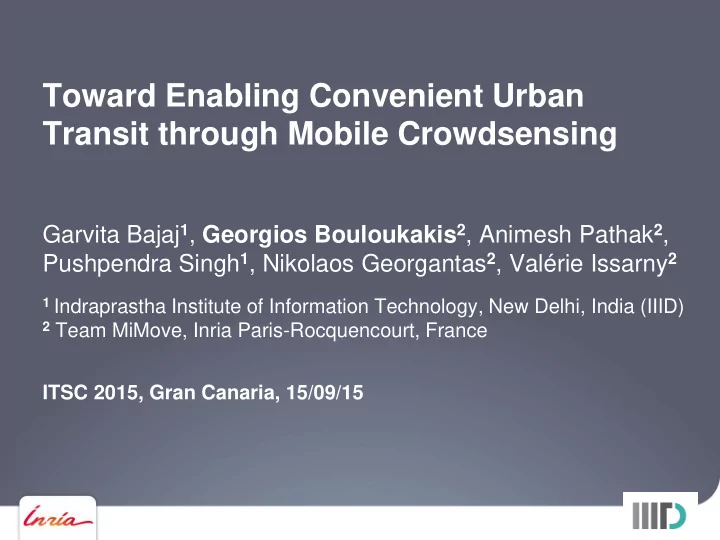

Toward Enabling Convenient Urban Transit through Mobile Crowdsensing Garvita Bajaj 1 , Georgios Bouloukakis 2 , Animesh Pathak 2 , Pushpendra Singh 1 , Nikolaos Georgantas 2 , Valérie Issarny 2 1 Indraprastha Institute of Information Technology, New Delhi, India (IIID) 2 Team MiMove, Inria Paris-Rocquencourt, France ITSC 2015, Gran Canaria, 15/09/15
from: Denfert Rochereau, to: La Défense Objective • Overall objective : improving transit facilities in cities • providing travelers a route with the most convenience • Enable our objective via developing: • mathematical model of user convenience during a multi- leg journey • middleware for enabling convenient transit by using crowdsourcing - 2
Need a convenience model for Metro transit nodes Long waiting times! - 3
Modeling the user’s convenience • A function of: Physical congestion Time delay + Seat availability - 4
Representing the Metro network • Stations as vertices of graph • Connecting lines as edges • Edges may belong to different lines • Lines may be connected at junction stations • Path P (o,d) = {L 1 ,L 2 ,…L n } where each leg is the sequence of vertices lying on the same line - 5
Time Inconvenience - 6
Congestion & Seating Inconvenience • Congestion: • Seating (I s ): • • (if any) must be reported personal reaction bubble 1 directly by the users • Overall inconvenience (I): 1 [Edward Hall, 1966] - 7
Middleware for Mobile Crowdsensing into the Metro • Α middleware for: 1. collect ground truth data required for identifying the constants a,b,c and η of the convenience model 2. p rovide a list of public transit modes that best meet the user specifications 3. collect and provide information through mobile applications • Efficient interaction by considering three basic constraints: • Connectivity • Energy efficiency • Timeliness (Freshness) of data - 8
Basic Interaction Paradigms Client-Server - CS (e.g., REST) CS client server Publish/Subscribe - PS (e.g., MQTT) subscriber PS publishers broker subscriber Tuplespace - TS (e.g., LightTS) reader publishers publishers TS writers tspace reader - 9
Mobile System Architecture Cloud Server cloud cloud broker tuplespace sender receiver mobile broker metro metro metro app app app metro line time OFF ON OFF ON OFF - 10
Android Application - Metro Cognition 1 • currently acts as a sender • collects values for constants a,b,c and η of the convenience model • collects connectivity tuples every 30 seconds using a background service the GoFlow 2 pub/sub middleware is • used for the submission of data 1 https://play.google.com/apps/testing/edu.sarathi.metroCognition - 11 2 https://goflow.ambientic.mobi/
Early Experiments – Convenience Analysis (1) • Similar experiments into the Metro of Paris and Delhi • 24 users participated (12 from each city) • Two goals: Identifying parameter values (a,b,c and η ) for a city-wide convenience model Identifying technique with best accuracy over the collected dataset • Dataset was heterogeneous – one legged, two legged, and three legged journeys: Preprocessing to separate out similar paths One Leg Two Legs Three Legs Total Paris 52 37 15 104 Delhi 7 38 53 98 - 12
Early Experiments – Convenience Analysis (2) Techniques used: Results: o Decision trees (DT) Method Average Accuracy o Multiclass Linear Decision Trees <75% Regression Multiclass Linear Regression ~75-80% o Support Vector SVM Overfitted accuracies reported Machines (SVM) Neural Networks ~79-98% o Neural Networks (NN) ? Comfort ? Seat ? Delay - 13
Early Experiments – Connectivity Analysis (1) • Experimental setup: analyzing the user’s connectivity pattern (internet connection) each connectivity pattern consists of many tuples for a specific path 2 business districts: La Défense (Paris) and Rajiv Chowk (Delhi) 2 residential districts: Cité Universitaire (Paris) and Govin-dpuri (Delhi) route in Paris: Cité Universitaire → La Défense, and back route in Delhi: Govindpuri → Rajiv Chowk, and back routes are classified to 3 categories: Morning, Mid-day, Evening - 14
Early Experiments – Connectivity Analysis (2) Results Morning Midday Evening Cité Universitaire - La Défense 51% 81% 83.5% Govind Puri - Rajiv Chowk 59% 88% 76% La Défense - Cité Universitaire 78% 81% 44% Rajiv Chowk - Govind Puri 82% 79% 51% - 15
Conclusion and future perspective • Enabling convenient urban transit through Mobile Crowdsensing • Introduce our inconvenient model and middleware platform • We develop convenience models for Delhi and Paris using machine learning techniques • We identify the ideal interaction paradigm regarding the constraints into the Metro Next step • use the developed convenience models to provide personalized mobility services • utilizing connectivity patterns as a realistic input-parameter to our queueing network - 16
Thank you Further information: Inria MiMove : https://mimove.inria.fr SARATHI : https://mimove.inria.fr/sarathi XSB : http://xsb.inria.fr - 17
Recommend
More recommend